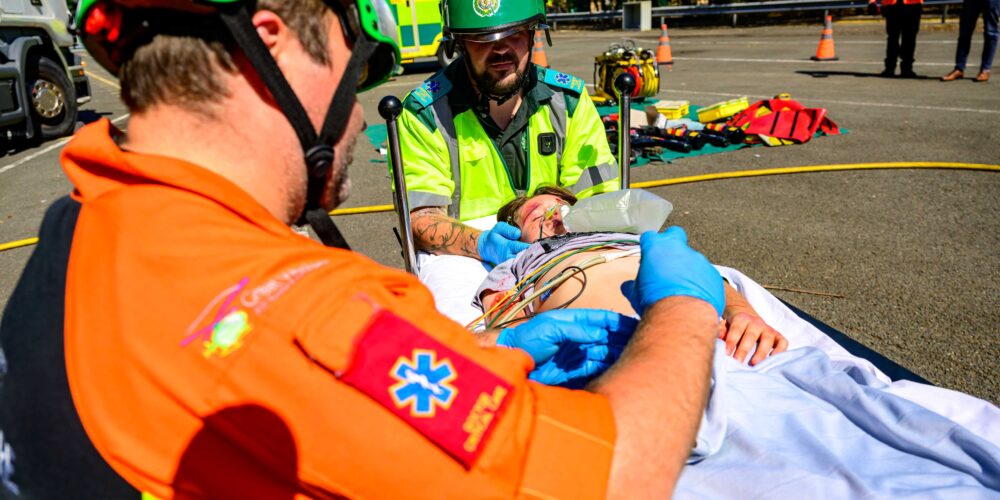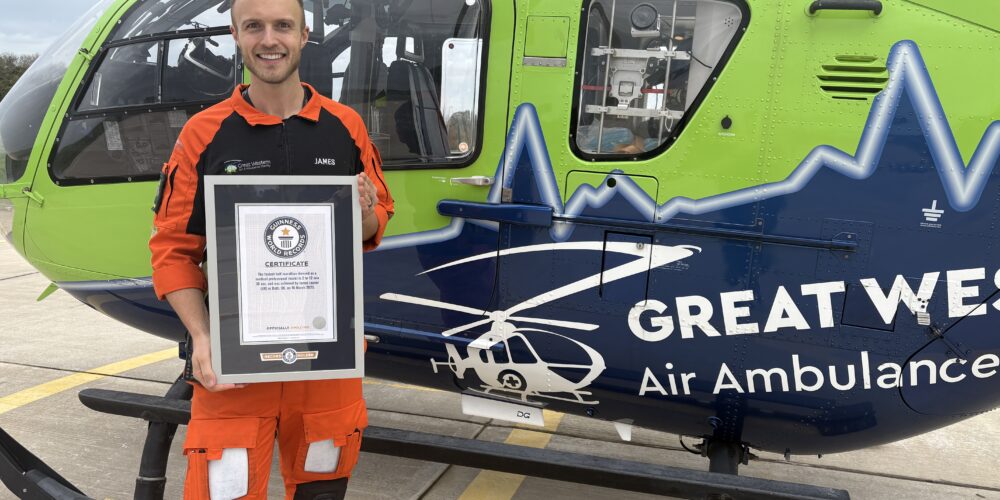
Did you know?
May 9, 2023
Keith’s Story
June 6, 2023On 16 May 2023, Great Western Air Ambulance Charity (GWAAC) and Avon Fire & Rescue Service (AF&RS) came together to host a multi-training agency day. Last year’s event had been such a success that they couldn’t not do it all over again.
This year’s training took place at Avonmouth Docks, courtesy of The Bristol Port Company; the excellent facilities meant that everyone could get stuck into some really challenging simulations (sims).
The day kicked off just after 10:00 with a group of over 40 attendees, including crew members from GWAAC, firefighters from AF&RS, student paramedics from the University of the West of England (UWE), and paramedics from South Western Ambulance Foundation Trust’s Hazardous Area Response Team (HART).
After an initial briefing, the attendees split into three smaller groups and headed off in different directions across the site to the sim locations.
Training together
The day followed a similar pattern to last year, where the groups moved around the three sims so everyone had a chance to work and learn from the different scenarios.
Each simulation presented an initial critical problem and ongoing changing circumstances. The crews had to think on their feet and communicate with each other the whole time.
Scenario one — a casualty was fitting at the top of a crane and stopped breathing. The groups had to get to the casualty, treat them, and get them down to safety.
Scenario two — two casualties had fallen down a hole filled with water. One had stopped breathing, the other had broken bones. The groups needed to get to the casualties, treat them, and get them up to ground level.
Scenario three — a casualty had been crushed by concrete blocks and was trapped. The groups had to treat the patient and work out how to free them. This sim involved some crucial decision-making about whether to amputate a trapped limb.
Why days like these are important
Here are a few words from the organisers and attendees themselves…
“The types of incidents we have trained for today, are thankfully quite rare, but it’s important that we are prepared so that when we do get called to something similar, all the different emergency services crews know how best to work together. Through training together we can ensure that we are making the best use of the teams’ capabilities to give the patients the best possible outcome.”
Dr Jules Blackham, Critical Care Doctor, Great Western Air Ambulance Charity
“Multi-agency training days like these are invaluable for building relationships, preparing for real-life scenarios, and helping to develop the paramedics of the future.”
Fleur Mosley, Specialist Paramedic in Critical Care.
“It’s been really valuable to see how all the services work together and how we fit into that.”
Erin, UWE Student paramedic
“It’s been a really good day seeing how the different services take leadership of different aspects of the simulations. It’s important to know how we all work so we can come together in real-life incidents.”
Callum, Firefighter, White Watch, Avon & Fire Rescue Service, Bedminster
“A brilliant multi-agency training day with lots of teamwork, fantastic patient care, and learning all around!”
Spokesperson, Code Red Training
Thank you, thank you
Without the people and organisations listed below, this year’s multi-agency training day would not be possible:
Thank you to The Bristol Port Company for the use of their site and to the Port Police for helping with the sims.
Thank you to AF&RS for co-hosting the day and putting our crews through their paces!
Thank you to the faculty staff and student paramedics at UWE for participating as crew, and to the students who did a wonderful job acting as casualties for the sims. UWE also provided lots of kit and did all the makeup — amazing!
Thank you to HART for lending kit and their involvement in the SIMS.
And thank you to Code Red Training for running the entrapment exercise, and to Steph who volunteered to role-play as the trapped patient and spent the best part of the day buried amongst concrete blocks.
The types of incidents we have trained for today, are thankfully quite rare, but it’s important that we are prepared so that when we do get called to something similar, all the different emergency services crews know how best to work together. Through training together we can ensure that we are making the best use of the teams’ capabilities to give the patients the best possible outcome.

Scenario one

Scenario one

Scenario two

Scenario three



